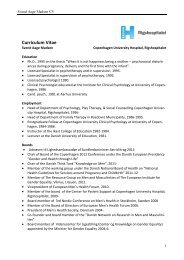Untitled
Untitled
Untitled
Create successful ePaper yourself
Turn your PDF publications into a flip-book with our unique Google optimized e-Paper software.
Lifestyle & Preventable Risk<br />
Factors<br />
Main points<br />
• Poor lifestyles and preventable risk factors are still some of the principal<br />
causes of premature death and morbidity in men, with over 50 % of<br />
premature deaths being avoidable.<br />
• There are strong links between the socioeconomic and educational<br />
background of men and their available health choices, which impact<br />
on their wellbeing.<br />
• A gender element exists with regards to men’s lifestyle choices, with<br />
social pressure increasing the likelihood of adopting risky behaviour.<br />
• There has been a steady reduction in smoking across Europe – but the<br />
levels are still highest amongst men in lower socioeconomic groups<br />
and in the Eastern European countries.<br />
• Alcohol consumption remains high in men, but differences are most<br />
noticeable for drunkenness and binge drinking.<br />
• Illicit drug use varies across Europe, but men tend to have greater use of<br />
cannabis, ecstasy and steroids, with more drug related deaths in men.<br />
• Though men have higher levels of activity than women<br />
generally, there are too few men taking sufficient exercise<br />
for health maintenance.<br />
• Men tend to have less nutritiously balanced diets, with above the<br />
recommended levels of dietary cholesterol and saturated fatty acids<br />
and lower levels of polyunsaturated fat, carbohydrate, and fibre.<br />
Higher than advised salt and other mineral levels adds to the negative<br />
health consequences of men’s diets.<br />
• Obesity is increasing across Europe and the male form of overweight<br />
with central fat deposition increases the risk of many health problems<br />
[with links to cardio-vascular disease, cancer and diabetes].<br />
• Men tend to accumulate fat at a faster rate than women, becoming<br />
more overweight at an earlier age.<br />
• It is difficult to make international comparisons relating to Sexually<br />
Transmitted Infections.<br />
• Programmes that target young men regarding screening for STI’s are<br />
proving successful.<br />
• Men tend to have a lower age of sexual initiation, have more partners,<br />
with condom use being greater in young men and those with higher<br />
levels of education.<br />
6








